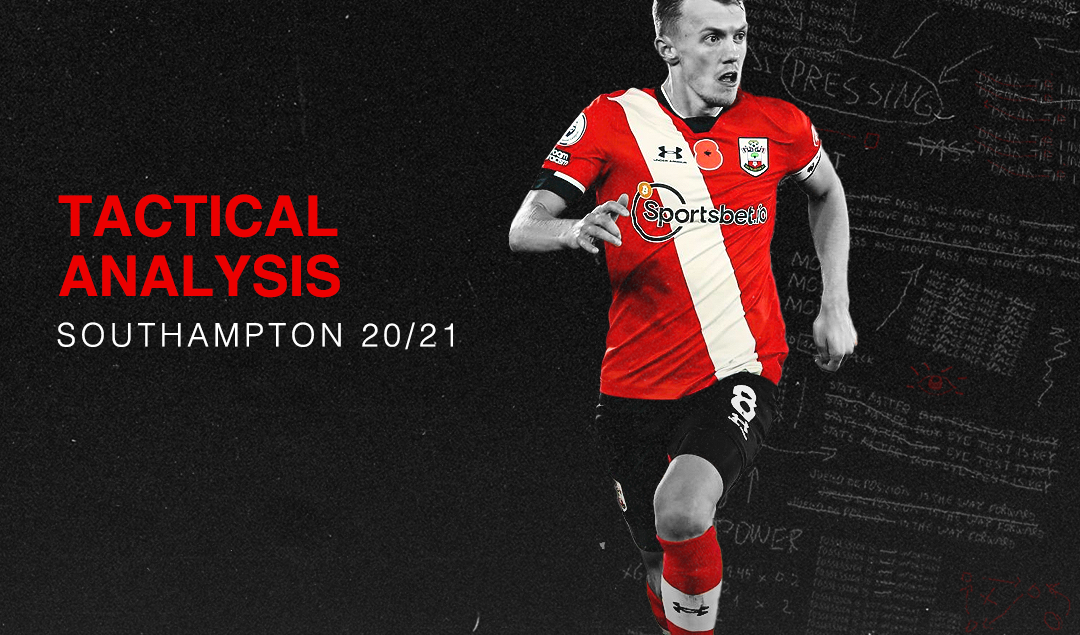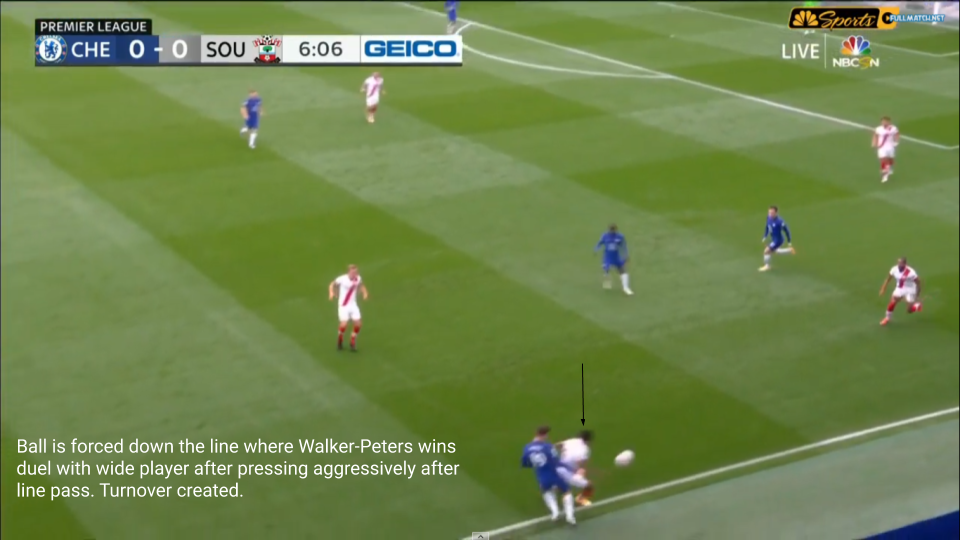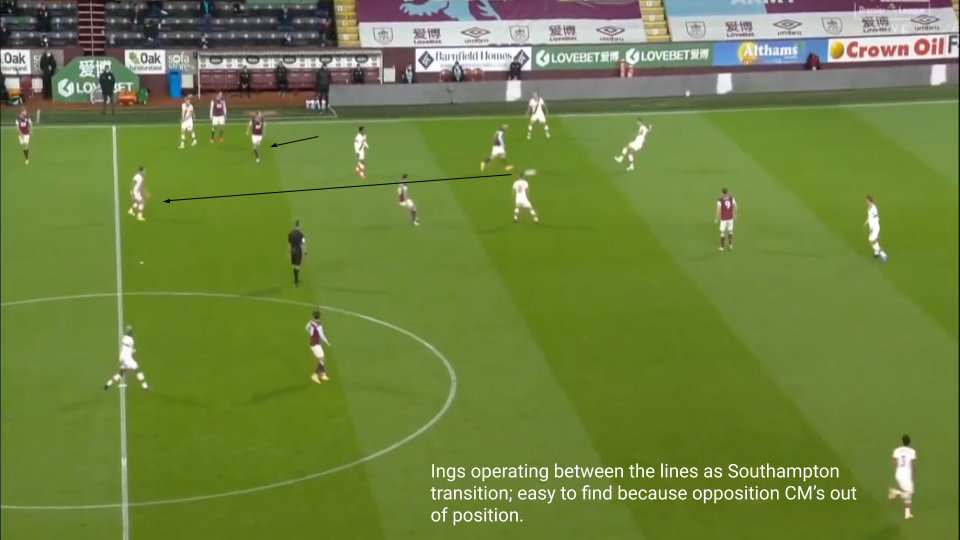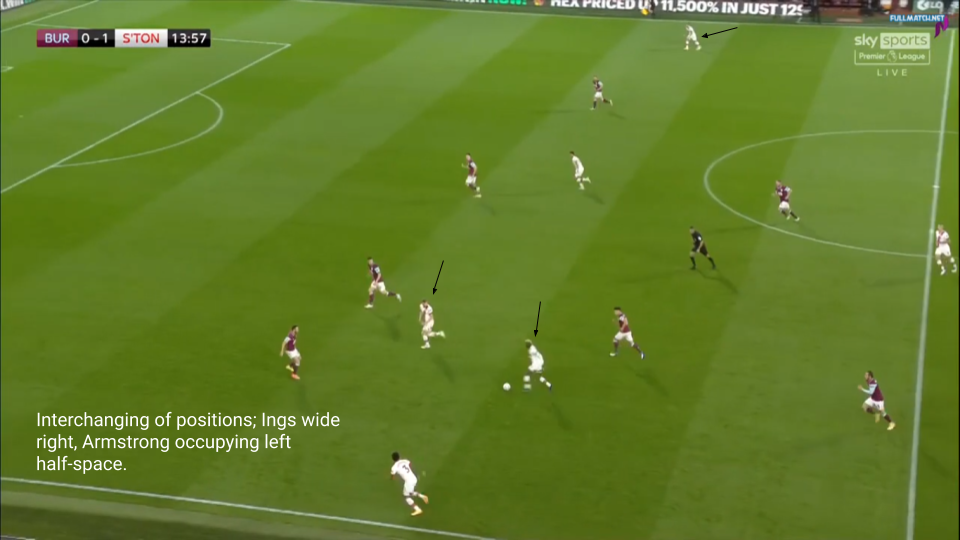Tactical Analysis: Southampton 2020/21
“Just over a year since their lowest point, Southampton reach their highest point”, said Sky Sports commentator Rob Hawthorne as Southampton, albeit temporarily, rose to the top of the Premier League for the first time in their history after a comfortable 2-0 win over Newcastle on the most recent Friday Night Football.
Southampton sat inside the top four at the start of the third international break of the 2020/21 season, which is truly representative of the remarkable turnaround Ralph Hasenhüttl has overseen in the last year. The faith that the club placed in the Austrian to guide Southampton forward after the embarrassing 9-0 home defeat to Leicester City last October has been, and continues to be repaid.
Many thought Hasenhüttl would be relieved from his duties after the Saints suffered their heaviest defeat in their history, however, the board saw the potential in the Austrian manager and decided to stick; a rare act in the unforgiving, modern game. That potential has been unleashed this season, as Southampton have won five of their opening eight Premier League fixtures.
The focus of this article will be a tactical analysis of Southampton’s start to the 20/21 season, and how they find themselves in the Champions League spaces with Christmas fast approaching.
Pressing
Hasenhüttl’s teams are well renowned for their aggressive nature out of possession, and this has been manifested by Southampton so far this season. Southampton press in a 4-4-2 shape, which is a setup that is common out of possession amongst Premier League teams.
The front two of Che Adams and Danny Ings, who have struck up an excellent partnership thus far, are tasked with blocking the passing lanes into central midfield rather than aggressively pressuring the opposition centre-backs.
The two wide midfielders remain relatively narrow, usually occupying the half-spaces. Therefore, they prevent central progression and in doing so naturally invite the opposition to move the ball to the flanks. This represents the main objective of Southampton’s pressing; funnel play wide and trap the opposition.
The wide trap is a common theme, especially when pressing in a 4-4-2 because teams naturally are inclined to block central progression when their opponents have deep possession, and this is even more evident when defending with just four players across the midfield line because it is difficult to cover the whole pitch horizontally, and therefore the team out of possession tend to concede the space out wide rather than inside because it is simply less dangerous. This invites the opposition to attempt to progress the ball down the flanks and often presents excellent opportunities to trap.
It is evident that the attitude switches when the opposition move the ball into wide areas; when the ball is deep and central, i.e with the centre backs, Saints remain narrow and compact, and rarely ever apply pressure on the ball. Rather, they focus on blocking passing lanes into advanced central areas.
However, when the ball moves wide, they apply aggressive, man-oriented pressure in attempt of either forcing a turnover or forcing the ball out of play. To manifest this, Southampton have attempted the most tackles in the middle of the pitch per 90 minutes this season, which shows where the Saints tend to apply pressure onto the opposition.
The trigger for the wide trap to begin is when the opposition centre-backs prepare to pass out wide. This results in Southampton’s wide midfielders jumping out wide in order to apply pressure when they receive the ball. In turn, the ball side central midfielder (either James Ward-Prowse or Oriol Romeu) apply pressure onto the opposition’s infield option (usually a centre midfielder), and the full back applies aggressive pressure onto the line pass. This essentially traps the opponent.
The level of pressure that Southampton apply in wide areas when out of possession makes it difficult for the opposition to play out because when the opposition receive possession, they are placed under immediate pressure which usually results in a duel as the Southampton players on the ball side are close enough to challenge for possession.
This forces many turnovers, which is the main advantage of the wide trap, as Southampton possess many players who are efficient in winning their duels, i.e both central midfielders. Consequently the Saints are able to regain possession and build attacks from there.
Southampton are well renowned for their high defensive line, which carries obvious risk, as shown by Tottenham in their 5-2 win at St Mary’s in September, however, this does allow them to remain compact between the lines when pressing. However, the main drawback of the aggressive pressing in wide areas is their over commitment to the ball side, which leaves them vulnerable on the far side if the opposition play out.
When Saints funnel the opposition’s possession out wide, the wide midfielder on the far side tucks inside to cover for the central midfielders who heavily shift across to support the pressing, however as a result, this leaves them extremely vulnerable to any switches after the opposition play their way through the press. This was extremely evident in the home win vs Everton.
Most teams like to stretch the pitch horizontally when they have possession because it usually stretches the opposition defensive structure which therefore opens up spaces to play in, however, Southampton are very ball side heavy and rather than spreading equally to defend the opposition’s width, they overcommit to one side when pressing which leaves them extremely vulnerable to switches.
Everton were able to create numerous two v ones when switching from right to left. Luckily the chances presented to the visitors came to no effect, however, they were representative of the risk that Southampton’s ball side heavy pressing carries.
Hasenhüttl has also implemented effective counter-pressing since he arrived at Southampton in 2018, and this has been manifested this season. As Jürgen Klopp once said, “no playmaker in the world can be as good as a good counter-pressing situation.”
Southampton like to hunt in packs when they concede possession high up. They are aggressive in the numbers they throw forward in attack, and thus they usually have adequate amounts of players around the ball for an effective counter-press. One fundamental aspect of Southampton’s counter-pressing is the way they support the press, as manifested in the image below.
Adding depth to the press essentially provides cover if the ball cannot be won in the original phase, and therefore the players who support the press are ready to engage and jump if the opposition player manages to retain possession after the first wave of pressure. This enhances the chances of winning the second ball, and therefore maximises the chances of a high turnover.
Direct transitions
There seems to be a common misconception in football regarding the word direct. Typically, when the word direct is used in football, it immediately brings connotations of a long-ball style of play which revolves around an aerially dominant set of players. Although this style of play is extremely direct, the word simply means moving in a specific direction without change, and therefore moving the ball forward on the ground at a quick pace is direct. This is the approach of Southampton’s transitions.
Firstly, Southampton’s squad is full of hard-working, duel dominant players who thrive in pressurising opposition players and forcing mistakes. Southampton lead the charts in terms of ball recoveries per 90 minutes which emphasises the defensive nous they possess out of possession, especially through the central midfield pairing of Ward-Prowse and Romeu. Therefore these ball recoveries naturally result in many opportunities to transition to attack.
The 4-4-2 shape out of possession is exceedingly effective when transitioning to attack because naturally there are two centre forwards to act as outlets. Teams that defend with just the single man forward can sometimes be susceptible to sustained pressure from an opponent because their sole outlet can become isolated and as a result, the team cannot get out and relieve pressure. However in this case, the centre forwards of Adams and Ings naturally act as the team’s outlets when they win possession from the opponent.
Hasenhüttl’s Saints usually transition via direct passes into the feet of either centre forward, who can either turn and run at the underloaded defence, or hold the ball up and bring runners into play, which is the prominent advantage of their transitions. Both Adams and Ings have shown their ability to hold the ball up under pressure from opposition defenders which allows runners from midfield to join counter attacks.
Southampton’s midfielders are extremely energetic and therefore they are able to transition from defence to attack effectively and offer support to the front two. This is often supplemented by the fact there are gaps in the opposition’s shape due to the transition, which makes it easier to feed the centre forwards as naturally the shape of the opposition is more open than in a sustained period of defending.
There are usually gaps between the lines of the opposition shape in transition, and Southampton take full advantage of this space. The front two, especially Danny Ings, has shown his ability to drop deep in between the lines to receive possession, and this is prominent when Southampton go on the counter.
Occupying space between the lines offers a predicament for defenders, especially in transition: Do I follow the centre forward into the space and risk leaving space in behind, or do I back off, remain in my position and risk the centre forward turning and running at the underloaded defence? Ings’ intelligent positioning causes panic amongst opposition defenders and allows Saints to transition effectively, and most importantly for Hasenhüttl, rapidly.
Direct transitions also allow Southampton to gain territory. After periods of defending against sustained possession, Southampton’s direct transitions allow pressure to be relieved, as essentially finding their centre forwards immediately allows them to move up the pitch as a unit because the forwards are typically the most advanced players in terms of positioning. This helps relieve pressure from the opponent and minimises the chances of being pinned in their own half for a longer period of time.
Narrow structure in possession
At the beginning of his tenure at St Mary’s, Hasenhüttl opted for a back five in the majority of matches, however, the Austrian has finally implemented his unique 4222 which led to great success in Germany with RB Leipzig. This change resulted in an up-turn in form last season, and that form has continued in this campaign.
The 4-2-2-2 naturally becomes a 4-4-2 out of possession, however, perhaps the most prominent difference between the two is the positioning of the wide midfielders. The structure of the attack is extremely narrow, and therefore the ‘wide midfielders’, predominantly Stuart Armstrong and Nathan Redmond, drift inside and operate centrally, taking up positions between the lines and in the half-spaces on their respective sides.
This maximises Southampton’s options between the lines and creates a multitude of progressive passing options. Therefore, the full-backs, typically Kyle Walker-Peters and Ryan Bertrand are both encouraged to advance forward and maintain width for the side on each wing.
Width is exceedingly important when in possession in the opponent’s half because it stretches the opponent. If you maintain width on each flank, the opponent will essentially have a greater amount of horizontal ground to cover, and therefore their defensive lines will become stretched; as a result, spaces between defenders will open up.
This width is vital for Southampton because it offers the opposition a predicament; leave the full-backs free on each side and focus on covering the space centrally?, or cover space horizontally and risk opening up central passing lanes into the abundance of players operating between the lines? This essentially makes it more simple for Southampton to progress the ball into the final third.
In addition to the effectiveness of the counter-pressing, the system has its advantages. An advantage of the 4-2-2-2 shape in possession is the increased amount of combination play between the lines. Presence between the lines is extremely valuable in football because it is difficult to defend against, especially for the opposition’s midfield line.
Operating on the blindside of the opposition midfield means they must scan consistently to understand the positioning of the attacking players in order to block passing lanes. However, when there are multiple options between the lines, this is difficult to contain due to the quantitative advantage of the attacking team. This means the ball can be progressed forward from the second phase, into the final third on a frequent basis, which only augments the combination play between the lines.
Football is sometimes more simple than made out to be, and progressing the ball to your most able attackers is representative of this. This is essentially what Southampton attempt to do; fire passes into the likes of Ings, Adams and Redmond and allow them to combine and create.
The quality of interchanging between the front four is also a considerable advantage of this system. The 4-2-2-2 naturally results in the four attacking players operating centrally, in close proximity with each other, and therefore they often tend to drift slightly wider or deeper in order to occupy more space.
This often leads to the attacking players occupying each other’s positions, i.e., Ings out wide, Arnstrong through the middle. The great advantage of this is it causes confusion amongst opposition defenders. Constant interchanging of positions has great benefits vs both a man oriented defence and a zonal oriented defence.
Against a man-oriented defence, interchanging allows the attackers to drag defenders out of position and create space for fellow attackers to drive into and exploit. Interchanging also proves challenging for a zonal oriented defence because this tasks defenders with challenging different players on numerous occasions during matches which can result in a variety of challenges and complications, and may be something they haven’t prepared for.
One drawback of Southampton’s 4-2-2-2 is its general overcommitment to attack, which therefore leaves them exposed in transition. The advanced midfielders partnered with high full-backs often leaves the Saints underloaded behind the ball when in possession and therefore susceptible to counter attacks.
Romeu usually protects the two centre-backs by maintaining a deep position when Southampton attack, however, his central midfield partner Ward-Prowse has tendencies to join attacks due to his natural box-to-box nature. This usually only leaves three players behind the ball in possession which is an extremely risky strategy and results in spaces for the opposition to attack in transition. This is why Southampton are vulnerable in defensive transition.
However, this does show Hasenhüttl’s commitment to attack, which manifests his aggressive philosophy, and is a serious reason why Southampton fans have fallen in love with the Austrian.
3-4-3 – an alternative or a sign of things to come?
Due to the injury sustained by left-back Ryan Bertrand, Southampton lined up in an unusual 3-4-3 in possession during their most recent match vs Newcastle. This was due to change in dynamics out wide, as Jack Stephens, typically a centre-back, stepped in for the injured Bertrand.
Walker-Peters and Bertrand provide great offensive potential due to their attacking nature and the areas they like to occupy on the pitch; they offer Southampton the vital width that is needed in order to break down a defensive block. So, in the absence of this attacking nous on the left flank, Hasenhüttl decided to adapt Southampton’s shape in possession.
The Austrian instead opted for a 3-4-3, as Walker-Peters advanced into a higher position, with Stephens slotting into defence to create a back three when Saints had possession. This essentially meant Southampton were building asymmetrically.
Asymmetrical full-backs consequently leads to asymmetrical wingers as the wide player on the same flank as the deep full-back must provide width on this flank. This was recently manifested by José Mourinho’s Tottenham, as Ben Davies tucked into defence to create a back three, meaning left winger Heung Min-Son was tasked with holding width on the left hand side of attack. In this case, Moussa Djenepo took up a wider position than usual and occupied close to the touchline.
Despite Djenepo’s wider position, Southampton still maintained excellent presence between the lines via attacking trio Theo Walcott, Stuart Armstrong and Che Adams. Although essentially the setup meant Southampton had one less player between the lines, their ball progression into these areas remained exceptional and was a fundamental reason why they were able to see off Newcastle comfortably.
On numerous occasions, Walcott received the ball between the lines on the half-turn and was able to drive at the heart of the Newcastle defence.
Another benefit of the asymmetrical full-back setup was that it allowed Southampton to create an advantage vs Newcastle’s first line of pressure. Recently, Newcastle have been defending in a 5-3-2 shape, so creating an overload vs the front two, Callum Wilson and Allan Saint-Maximin was vital to Southampton’s ball progression. This allowed Southampton to achieve a higher standard of deep ball circulation and therefore the ball was progressed with great ease.
Building with a back three also allowed Southampton another player behind the ball to support defensive transitions. As mentioned previously, Southampton usually attack with high full-backs which can often leave them vulnerable to counter attacks, however, an extra player behind the ball allowed Southampton to deal with Newcastle’s transitions effectively and therefore nullify their counter-attacks entirely.
We are yet to see whether this setup was just a one off due to the absence of Bertrand, however, it is definitely something Hasenhüttl should consider sticking with in the future. This could be done via implementing a flexible build-up shape; one that sees the full-back on the ball side remain deep, whilst the full-back on the far side stretches the pitch and maintains width for the side on the opposite flank.
The extra player behind the ball allowed Southampton to maintain great defensive security whilst in possession, and their excellent presence between the lines remained. This resulted in a well-assured performance.
Conclusion
In conclusion, Southampton are a well-drilled unit who possess excellent presence between the lines. Hasenhüttl also prefers to block the opposition’s central options whilst leaving space out wide, before instructing his team to trap the opposition when the ball is moved out wide. The gritty, hard-working, difficult to play against attitude is representative of their excellent start to the new season.
It is yet to be seen whether or not the Saints can continue this exceptional run of form over a sustained period, however, all the signs back that statement. It will be interesting to see how Hasenhüttl copes without star man Ings in the coming weeks. If Southampton continue to operate in the top six until Ings returns, this season could be an extremely exciting one for Hasenhüttl and the club.
By: Ollie Himsworth
Featured Image: @GabFoligno / Michael Steele / AFP















